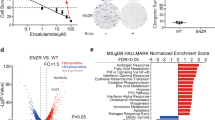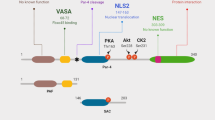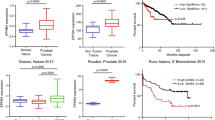Abstract
To determine if TRAIL-induced apoptosis in human prostate tumor cells was suppressed by bcl-2, we compared the levels of apoptosis induced by recombinant human TRAIL in pairs of isogenic cell lines that do or do not express bcl-2. Three human prostate tumor cell lines (PC3, DU145 and LNCaP) and their bcl-2-expressing counterparts were tested for their susceptibility to TRAIL. Cells were exposed to TRAIL in the presence of cycloheximide which acted as a sensitizer. Apoptosis was induced rapidly in PC3 and DU145 neo-control transfected cells, whereas induction in LNCaP required 24 h. All three cell line variants expressing bcl-2 were resistant to the apoptotic effects of TRAIL. Caspase 3 and 8 activation was also detected in the neo control cells after treatment with TRAIL, demonstrating the rapid activation of the caspase cascade similar to that seen with other death receptors. Bcl-2 overexpression in these cells blocked activation of these caspases, suggesting that bcl-2 expression of human cancer cells may be a critical factor in the therapeutic efficacy of TRAIL.
This is a preview of subscription content, access via your institution
Access options
Subscribe to this journal
Receive 50 print issues and online access
$259.00 per year
only $5.18 per issue
Buy this article
- Purchase on Springer Link
- Instant access to full article PDF
Prices may be subject to local taxes which are calculated during checkout








Similar content being viewed by others
References
Ashkenazi A, Dixit VM . 1998 Science 281: 1305–1308
Belka C, Rudner J, Wesselborg S, Stepczynska A, Marini P, Lepple-Wienhues A, Faltin H, Bamberg M, Budach W, Schulze-Osthoff K . 2000 Oncogene 19: 1181–1190
Bodmer JL, Holler N, Reynard S, Vinciguerra P, Schneider P, Juo P, Blenio J, Tschopp J . 2000 Nature Cell Biol. 2: 241–243
Boesen-de Cock JGR, Tepper AD, de Vries E, van Blitterswijk WJ, Borst J . 1999 J. Biol. Chem. 274: 14255–14261
Boise LH, Thompson CB . 1997 Proc. Natl. Acad. Sci. USA 94: 3759–3764
Bonavida B, Ng CP, Jazirehi A, Schiller G, Mizutani Y . 1999 Int. J. Oncol. 15: 793–802
Degli-Esposti MA, Dougall WC, Smolak PJ, Waugh JY, Smith CA, Goodwin RG . 1997 Immunity 7: 813–820
Emery JG, McDonnell P, Burke MB, Deen KC, Lyn S, Silverman C, Dul E, Appelbaum ER, Eichman C, DiPrinzio R, Dodds RA, James IE, Rosenberg M, Lee JC, Young PR . 1998 J. Biol. Chem. 273: 14363–14367
Enari M, Hug H, Nagata S . 1995 Nature 375: 78–81
Engels IH, Stepczynska A, Stroh C, Lauber K, Berg C, Schwenzer R, Wajant H, Janicke RU, Porter AG, Belka C, Gregor M, Schulze-Osthoff K, Wesselborg S . 2000 Oncogene 19: 4563–4573
Fulda S, Meyer E, Debatin KM . 2000 Cancer Res. 60: 3947–3956
Gazitt Y . 1999 Leukemia 13: 1817–1824
Gazitt Y, Shaughnessy P, Montogomery W . 1999 Cytokine 11: 1010–1019
Griffith TS, Chin WA, Jackson J, Lynch DH, Kubin MZ . 1998 J. Immunol. 161: 2833–2840
Gross A, Yin XM, Wang K, Wei MC, Jockel J, Milliman C, Bromage-Erdjument H, Tempst P, Korsmeyer SJ . 1999 J. Biol. Chem. 274: 1156–1163
He H, Qi X-M, Grossmann J, Distelhorst CW . 1998 J. Biol. Chem. 273: 25015–25019
Irmler M, Thome M, Hahne M, Schneider P, Hofmann K, Steiner V, Bodmer JL, Schroter M, Burns K, Mattman C, Rimoldi D, French LE, Tschopp J . 1997 Nature (Lond). 388: 190–195
Itoh N, Tsujimoto Y, Nagata S . 1993 J. Immunol. 151: 621–627
Jaattela M, Benedict M, Tewari M, Shayman JA, Dixit VM . 1995 Oncogene 10: 2297–2305
Jacobson MD, Weil M, Raff MC . 1996 J. Cell. Biol. 133: 1041–1051
Jo M, Kim TH, Seol DW, Esplen JE, Dorko K, Billiar TR, Strom SC . 2000 Nature Med. 6: 564–567
Keogh SA, Walczak H, Bouchier-hayes L, Martin SJ . 2000 FEBS Lett. 471: 93–98
Korsmeyer SJ . 1992 Blood 80: 879–886
Kuwana T, Smith JJ, Muzio M, Dixit V, Newmeyer D, Kornbluth S . 1998 J. Biol. Chem. 273: 16589–16594
Mariani SM, Matiba B, Armandola E, Krammer PH . 1997 J. Cell Biol. 37: 211–229
Martin SJ, Lennon SV, Bonham AM, Cotter TG . 1990 J. Immunol. 145: 1859–1867
Miyashita T, Reed JC . 1993 Blood 81: 151–157
Pan G, O'Rourke K, Chinnaiyan AM, Gentz R, Ebner R, Ni J, Dixit VM . 1997a Science 276: 111–113
Pan G, Ni J, Wei YF, Yu GI, Gentz R, Dixit VM . 1997b Science 277: 815–818
Pitti RM, Marsters SA, Ruppert S, Donahue CJ, Moore A, Ashkenazi A . 1996 J. Biol. Chem. 271: 12687–12690
Rieger J, Naumann U, Glaser T, Ashkenazi A, Weller M . 1998 FEBS. Lett. 427: 124–128
Scaffidi C, Fulda S, Srinivasan A, Friesen E, Li F, Tomaselli KJ, Debatin KM, Krammer PH, Peter ME . 1998 EMBO J. 17: 1675–1687
Schulze-Osthoff K, Ferari D, Los M, Wesselborg S, Peter ME . 1998 Eur. J. Biochem. 254: 439–459
Sellins KS, Cohen JJ . 1987 J. Immunol. 139: 3199–3206
Sheridan JP, Marsters SA, Pitti PM, Gurney A, Skubatch M, Baldwin D, Ramakrishnan L, Gray CL, Baker K, Wood WI, Goddard AD, Godowski P, Ashkenazi A . 1997 Science 277: 818–821
Slee EA, Keogh SA, Martin SJ . 2000 Cell Death Differ. 7: 556–565
Snell V, Clodi K, Zhao S, Goodwin R, Thomas EK, Morris SW, Kadin ME, Cabanillas F, Andreeff M, Younes A . 1997 Br. J. Hematol. 99: 618–624
Sun S-Y, Yue P, Zhou J-Y, Wang Y, Kim H-RC, Lotan R, Wu GS . 2001 Biochem. Biophys. Res. Commun. 280: 788–797
Tang C, Willingham MC, Reed JC, Miyashita T, Ray S, Ponnatupur V, Huang Y, Mahoney ME, Bullock G, Bhalla K . 1994 Leukemia 8: 1960–1969
Thomas WD, Hersey P . 1998 J. Immunol. 161: 2195–2200
Tsuchida H, Takeda Y, Takei H, Shinwaza H, Takahashi T, Sendo F . 1995 J. Immunol. 157: 2403–2412
Yamada K, Ichikawa F, Ishiyama SS, Yuan X, Nonaka K . 1999 Diabetes 48: 478–483
Yu R, Mandlekar S, Ruben S, Ni J, Kong Tony AN . 2000 Cancer Res. 60: 2384–2389
Walczak H, Miller RE, Arial K, Gliniak B, Griffith TS, Kubin M, Chin W, Jones J, Woodward A, Le T, Smith C, Smolak P, Goodwin R, Rauch CT, Schuh JCA, Lynch DH . 1999 Nature Med. 5: 157–163
Walczak H, Bouchon A, Stahl H, Krammer PH . 2000 Cancer Res. 60: 3051–3057
Wallach D . 1984 J. Immunol. 132: 2464–2469
Woo M, Hakem R, Soengas MS, Duncan GS, Shahinian A, Kagi D, Hakem A, McCurrach M, Khoo W, Kaufman SA, Senaldi G, Howard T, Lowe S, Mak TW . 1998 Genes Dev. 12: 806–819
Zhang XD, Franco A, Myers K, Gray C, Nguyen T, Hersey P . 1999 Cancer Res. 59: 2747–2753
Acknowledgements
This study was supported in part by grants RO1 CA69003, PO1 CA06294 and P30 CA16672 from the National Cancer Institute.
Author information
Authors and Affiliations
Rights and permissions
About this article
Cite this article
Munshi, A., Pappas, G., Honda, T. et al. TRAIL (APO-2L) induces apoptosis in human prostate cancer cells that is inhibitable by Bcl-2. Oncogene 20, 3757–3765 (2001). https://doi.org/10.1038/sj.onc.1204504
Received:
Revised:
Accepted:
Published:
Issue Date:
DOI: https://doi.org/10.1038/sj.onc.1204504
Keywords
This article is cited by
-
Harnessing TRAIL-induced cell death for cancer therapy: a long walk with thrilling discoveries
Cell Death & Differentiation (2023)
-
The regulation of combined treatment-induced cell death with recombinant TRAIL and bortezomib through TRAIL signaling in TRAIL-resistant cells
BMC Cancer (2018)
-
Reciprocal amplification of caspase-3 activity by nuclear export of a putative human RNA-modifying protein, PUS10 during TRAIL-induced apoptosis
Cell Death & Disease (2017)
-
PU.1 supports TRAIL-induced cell death by inhibiting NF-κB-mediated cell survival and inducing DR5 expression
Cell Death & Differentiation (2017)
-
Potential Role of TRAIL in Metastasis of Mutant KRAS Expressing Lung Adenocarcinoma
Cancer Microenvironment (2016)



